November 26, 2018
The CNC PILOT 640 lather control from HEIDENHAIN
Create CNC programs at the stroke of a key
The innovative programming capabilities of the CNC PILOT 640 from HEIDENHAIN make it the perfect lathe control for the shop floor. Its ease of use and contouring motion accuracy are key features that it shares with HEIDNENHAIN milling controls. A particular strength of the CNC PILOT 640, however, is its intelligent user support for program creation.
The CNC PILOT 640 lathe control from HEIDENHAIN stands out for its fast and effective approach to creating NC programs. The control has carved out a special role in shop-floor programming by relieving the user of ordinary programming work and freeing him up for more demanding process optimization tasks.
The CNC PILOT 640 supports the user with the following main programming tools:
- Interactive contour programming (ICP) provides graphical support for programming the workpiece.
- Automatic program generation with TURN PLUS creates a complete NC program at the stroke of a key.
- Convenient programming in smart.Turn with its easy-to-understand program units allows for modification of the NC program at any time.
- The intuitive touchscreen shows context-sensitive dialogs, graphics, and 2-D or 3-D simulations that help the user test the NC program and readily add missing data.
Interactively program contours
The basis of every production process is the workpiece drawing. With the CNC PILOT 640, drawings are easily put at the control’s disposal, either by means of interactive contour programming (ICP) or through direct import of the drawing from a DXF file. The ICP tool merely requires
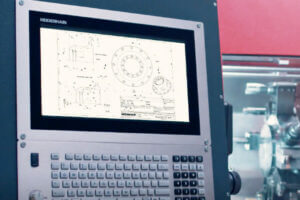
a description of the workpiece blank and the finished part based on the contour elements and their specified dimensions. The user enters these dimensions and data into an intuitive dialog screen, or he can model the workpiece using graphics-supported programming. If the drawing is available as a DXF file, the contour is simply imported.
During program data entry, the user enjoys considerable leeway in describing the contour elements. He can choose between absolute or incremental coordinates, lines defined by their end point or length, circular arcs described by their center or radius, and tangential or non-tangential transitions between elements. While entering these data, the user can always display a graphical image depicting the newly entered information.
The CNC PILOT 640 then automatically calculates any missing coordinates, intersections, center points, etc., provided that they are mathematically definable. If multiple solutions exist, the CNC PILOT 640 displays the mathematically possible variants in a dialog. The user can then select the desired solution and modify existing contours or easily enter his own solution.
Automatically generate NC programs with TURN PLUS
Once the workpiece has been programmed, the mere stroke of a key prompts TURN PLUS to generate an NC program in very little time. The user need only specify the clamping devices and workpiece material. TURN PLUS automatically takes care of the rest, including contour analysis, selection of the machining strategy, tooling, and cutting data, and the programming of the NC blocks. While the program is being generated, the CNC PILOT 640 provides a graphical simulation of the individual work steps currently being processed, thereby allowing the user to literally picture the NC program. Because TURN PLUS incorporates all of these data into the NC program, a 3-D model of the workpiece becomes available upon completed program creation, even if the user originally imported 2-D data from a DXF file.
The final result of the TURN PLUS automatic program creation process is a fully commented smart.Turn program. This program is not limited to standard turning processes: TURN PLUS can generate units for drilling and milling operations that employ a C axis or Y axis on front faces and lateral surfaces. On machines with a counter spindle, the program can also handle rear-face machining. Workpiece handovers between spindles can be implemented if the machine manufacturer sets up an appropriate cycle.
Thanks to the support provided by TURN PLUS, the CNC PILOT 640 allows the user to devote more time to other value-added tasks. Upon defining the geometry, users can benefit from time savings of up to 90 percent—time that would otherwise be needed for the conventional programming of the machining operation. At the same time, the automatically generated program provides greater reliability for the initial NC program run.
TURN PLUS is also an attractive solution for calculating the cost of machining jobs. This is because TURN PLUS is among the standard functions of the DataPilot CP 640 programming station software, which can be installed on every PC or notebook. Since programs created with TURN PLUS are accompanied by a highly realistic simulation of the machining process, the user can use TURN PLUS as a reliable cost calculation tool to obtain meaningful information about the expected machining time.
Create well-structured programs with smart.Turn
A smart.Turn program created with TURN PLUS is subdivided into discrete, easy-to-read machining blocks known as units. A unit completely and unambiguously describes a single machining step. These units are based on the tried-and-true G-code programming language (ISO). At a single glance, the user gains an overview of the tool, technology, contour, and cycle parameters, which are all arranged in clearly structured forms and illustrated by context-sensitive help images. The smart.Turn solution thus ensures that every unit is correctly and completely defined.
The intuitive program structure enables the user to quickly and easily run opened smart.Turn programs at any time. Once created, a program can be used repeatedly, with the user simply adapting the program to any new parameters. This can be done either by changing the entered values directly in the smart.Turn program or through the use of graphics-supported programming. When optimizing special machining tasks, the user can thereby leverage his specialist knowledge about the machining operation, the material to be machined, and the tools to be used. While programming the CNC PILOT 640, the user can also take advantage of powerful turning, milling, and drilling cycles. Thread cycles, as well as milling and drilling patterns, are included in the standard set of functions.
Enjoy intuitive and efficient operation in a networked production environment
The CNC PILOT 640 is innovative not only when it comes to program creation but also in how the control itself is operated. As with a smartphone or tablet, operation of the control is performed via gestures on a touchscreen. This intuitive approach is of particular value when users work in numerous graphical views or when graphics-supported programming is employed. In all of its display modes, the CNC PILOT 640 provides straightforward, context-sensitive support that delivers only the information currently needed for the programming, operation, and monitoring of both the control and the machine. Help images that appear during program entry, for example, illustrate the required parameters. During the simulation of NC programs, all tool movements are depicted in detailed realism, so that collisions are easy to detect. During program execution, the CNC PILOT 640 also displays complete information regarding the tool position, speed, and drive load, as well as the current machine status.
Even if, or rather, precisely because the strengths of the CNC PILOT 640 lie in shop-floor programming, intelligent integration into the corporate network makes a lot of sense. To this end, the solutions offered by Connected Machining are also available for the CNC PILOT 640. With this software, the user in the shop can pull up all of the required data (e.g., DXF files for importing contours) from the network and use them directly on the control. With the help of REMOTE DESKTOP MANAGER, the user can also switch to the user interface of a Windows PC. He then gains digital access to technical drawings, CAD files, NC programs, tool data, work instructions, parts lists, and warehouse information, all directly on the machine. Meanwhile, the StateMonitor software and the Extended Workspace expanded display system allow users to keep an eye on the status of the connected machines anytime and anywhere.
Exploit versatility for the shop
The CNC PILOT 640 can control CNC lathes equipped with a main spindle and counter spindle, a C axis, or a positionable spindle and driven tools, as well as machines featuring a Y axis and B axis. In multi-channel machining, different machining steps can be performed simultaneously using multiple slides. The CNC PILOT 640 thus covers the full production spectrum, ranging from simple turned parts to complex workpieces.
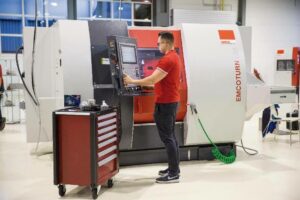
The CNC PILOT 640 is the ideal control for lathes such as EMCOTURN turning centers, whose strengths shine in a shop setting.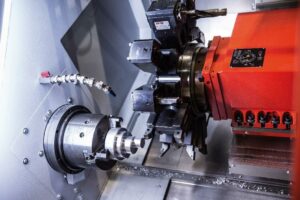
From simple turned parts to complex workpieces: the CNC PILOT 640 can also handle drilling and milling operations on front face and lateral surfaces, as well as handle rear-face machining.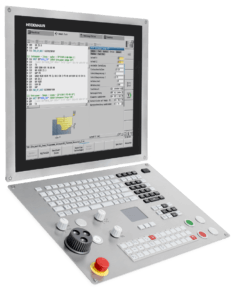
Clear and well structured: the smart.Turn program, machining parameters, and workpiece drawing are displayed side-by-side on the touchscreen of the CNC PILOT 640.
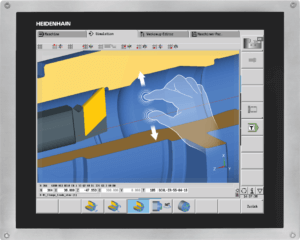
Touchscreen operation of the CNC PILOT 640 is performed via intuitive gestures already well known from smartphones and tablet PCs.

